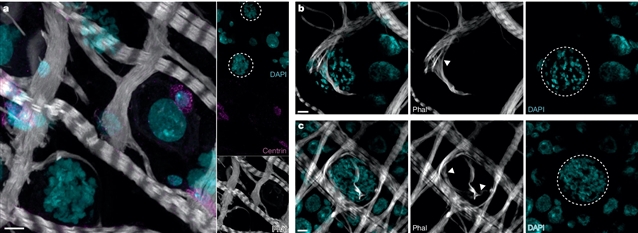
美国霍华德·休斯医学研究所Flaminia Catteruccia团队的一项最新研究绘制疟原虫在雌性按蚊中的转变和相互作用。相关论文于2025年10月22日发表于国际顶尖学术期刊《自然》杂志上。
通过对寄生虫和蚊子细胞在不同发育阶段和代谢条件下的单细胞RNA测序,研究组揭示了发生在中肠的关键转变和蚊子-寄生虫相互作用。功能分析揭示了调节卵囊生长的过程,并确定了疟原虫转录因子PfSIP2对人肝细胞孢子子感染至关重要。结合共聚焦显微镜对共享蚊子-寄生虫条形码的分析,研究组发现寄生虫在上皮杂交过程中优先与中肠祖细胞相互作用,可能将它们的基础位置作为退出标志。
此外,研究组发现细胞外晚期卵囊和周围的鞘细胞之间的紧密联系可能确保寄生虫粘附在中肠。课题组研究人员证实了他们在几种蚊子-寄生虫组合中的主要发现,包括田间来源的寄生虫。他们的研究提供了对分子事件的基本见解,这些分子事件表征了以前无法获得的生物转变和蚊子-寄生虫相互作用,并确定了传播阻断策略的候选物。
研究人员表示,人类疟疾寄生虫,恶性疟原虫,完全依靠按蚊传播。一旦在吸血过程中被摄入,大多数寄生虫在蚊子的中肠腔或上皮穿越过程中死亡。存活的卵母细胞如何与中肠细胞相互作用并形成卵囊尚不清楚,但这些步骤对于启动一个显著的生长过程至关重要,最终产生感染性孢子子体的需求。
附:英文原文
Title: Mapping Plasmodium transitions and interactions in the Anopheles female
Author: Yan, Yan, Verzier, Lisa H., Cheung, Elaine, Appetecchia, Federico, March, Sandra, Craven, Ailsa R., Du, Esrah, Probst, Alexandra S., Rinvee, Tasneem A., de Vries, Laura E., Kauffman, Jamie, Bhatia, Sangeeta N., Nelson, Elisabeth, Singh, Naresh, Peng, Duo, Shaw, W. Robert, Catteruccia, Flaminia
Issue&Volume: 2025-10-22
Abstract: The human malaria parasite, Plasmodium falciparum, relies exclusively on Anopheles mosquitoes for transmission. Once ingested during blood feeding, most parasites die in the mosquito midgut lumen or during epithelium traversal1. How surviving ookinetes interact with midgut cells and form oocysts remains poorly understood, yet these steps are essential to initiate a remarkable growth process culminating in the production of thousands of infectious sporozoites2. Here, using single-cell RNA sequencing of both parasites and mosquito cells across different developmental stages and metabolic conditions, we unveil key transitions and mosquito–parasite interactions that occur in the midgut. Functional analyses uncover processes that regulate oocyst growth and identify the Plasmodium transcription factor PfSIP2 as essential for sporozoite infection of human hepatocytes. Combining shared mosquito–parasite barcode analysis with confocal microscopy, we reveal that parasites preferentially interact with midgut progenitor cells during epithelial crossing, potentially using their basal location as an exit landmark. Additionally, we show tight connections between extracellular late oocysts and surrounding muscle cells that may ensure parasite adherence to the midgut. We confirm our major findings in several mosquito–parasite combinations, including field-derived parasites. Our study provides fundamental insight into the molecular events that characterize previously inaccessible biological transitions and mosquito–parasite interactions, and identifies candidates for transmission-blocking strategies.
DOI: 10.1038/s41586-025-09653-0
Source: https://www.nature.com/articles/s41586-025-09653-0
Nature:《自然》,创刊于1869年。隶属于施普林格·自然出版集团,最新IF:69.504
官方网址:http://www.nature.com/
投稿链接:http://www.nature.com/authors/submit_manuscript.html
